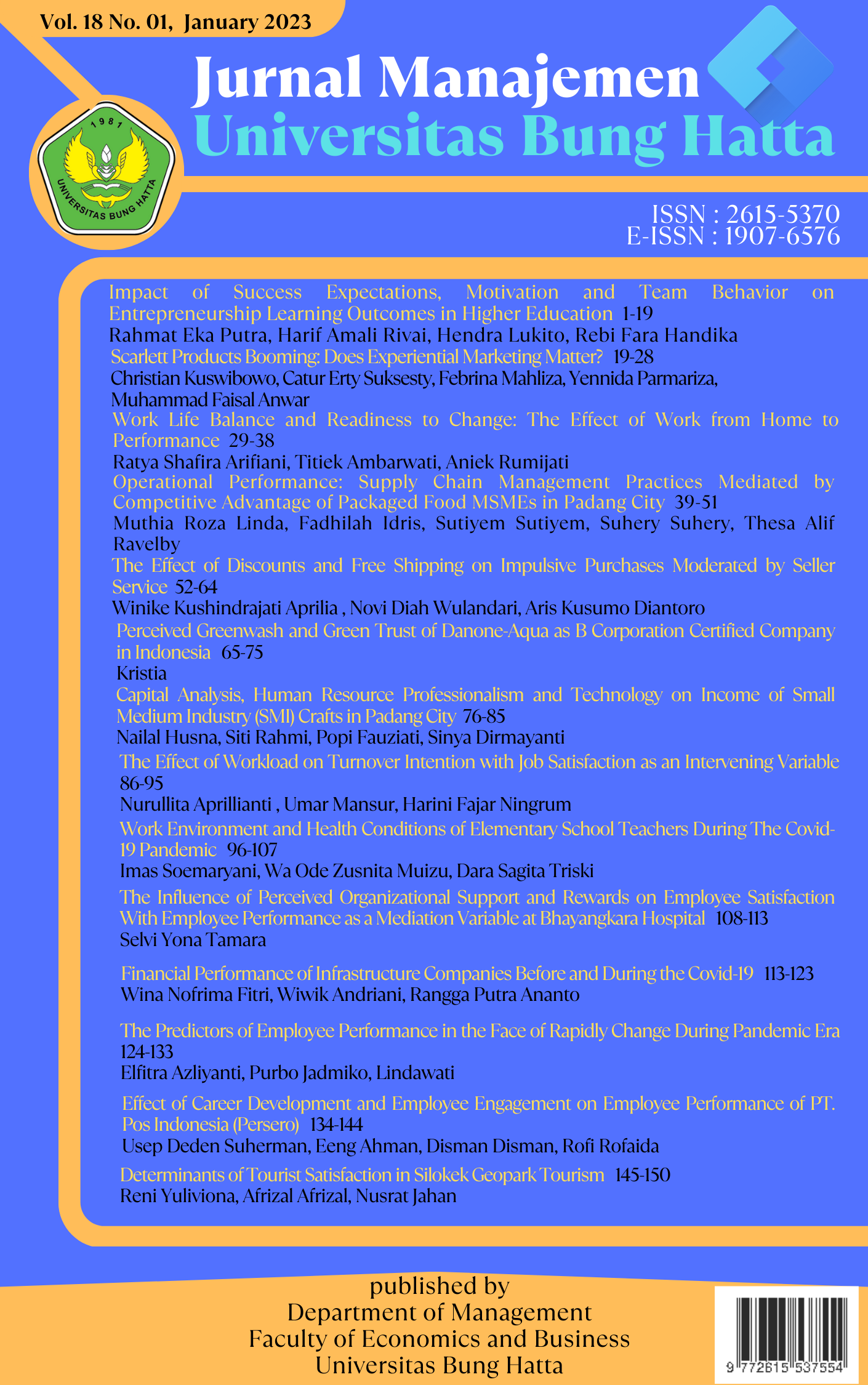Effect of Career Development and Employee Engagement on Employee Performance of PT. POS Indonesia (Persero)
DOI:
https://doi.org/10.37301/jmubh.v18i1.22063Keywords:
career development, employee engagement, employee performanceAbstract
ABSTRACT
The purpose of this study is to determine and analyze the impact of career development and employee engagement on employee performance, either separately or simultaneously.
The survey methods used in this study are descriptive and explanatory. The research was carried out on 87 employees PT Indonesia Pos (Persero). The saturated sampling technique was used for sampling. Multiple Regression Analysis was used to analyze the data.
According to the study's findings, career development and employee engagement have a combined or partial impact on employee performance. Furthermore, the determinant value is 0.800, indicating that career development and employee engagement can account for 80% of employee performance. Other factors accounted for 20% of the variance.
Keywords: Career Development, Employee Engagement, Employee Performance
References
Agrawala Tanuja, (2018), Factor Influencing Career Choice of Management Student in India, Career Development International, Vol.13 No.4, pp.362-376
Albrecht, L. S. (2012). Handbook of employee engagement. Northamptom: Edward. Elgar Press
Anitha, J. (2014). Determinants of employee engagement and their impact on Employee performance. International Journal of Productivity and Performance Management, 63(3), 308-323
Bernardin, H Jhon and Joyce E. A Russel. (2014). Human Resources Management: An Experintial Approach Editioan 5 : New York: MacGrow Hill Inc.
Cataldo, P. (2012). Focusing on Employee Engagement: How to Measure It and Improve It. White Paper. UNC Kenan-Flagler Business School. UNC Executive Development. North Carolina.
Dessler, Gary. (2017). Manajemen Sumberdaya Manusia. Jakarta: INDEKS.
Dubrin, Andrew J. (2015). Leadership: The Complete Ideal's Guide. Jakarta: Prenada Media
Eldor, L., & Vigoda-Gadot, E. (2017). The nature of employee engagement: Rethinking the employee organization relationship. The International Journal of Human Resource Management, 28(3), 526-552.
Gallup, G. (2016). Gallup study: Engaged employees inspire company innovation.(The Gallup Management Journal.
Gibson, Ivancevich, Donelly, (2017), Perilaku Struktur Proses Organisasi 2, Terjemahan. Jakarta :Penerbit Binarupa Aksara
Gyensare, M. A., Anku-Tsede, O., Boakye, K. O., & Twumasi, E. (2018). Occupational health and safety and employee engagement: Evidence from the SMEs sector in Ghana. International Conference on Applied Human Factors and Ergonomics: 202-216.
Ivancevich John M. (2014). Human Resource Management, Ninth Edition., McGraw Hill Companies, Inc., USA.
Kaengke, A.S., B. Tewal, dan Y. Uhing. (2018). Pengaruh Pengembangan Karier, Pelatihan dan Motivasi terhadap Kinerja Karyawan pada PT Air Manado. Jurnal EMBA. 6(1): 341-350.
Macey, W. H., & Schneider, B. (2018). The meaning of employee engagement. Industrial and Organizational Psychology, 1(1), 3-30.
Mangkunegara, A.A.A.P. (2016). Manajemen Sumber Daya Manusia. Remaja Rosdakarya. Bandung.
Marciano, P.L. (2012). Carrot and Sticks Don’t Work: Build a Culture of Employee Engagement with the Principles of Respect. McGraw Hill. Manhattan.
Mathis, Robert L. and John H. Jackson, (2017), Human Resources Management, Jakarta: Salembah empat Jakarta
Meere, M. (2015). High cost of disengaged employees. Victoria: Swinburne University of Technology.
Mondy ,R Wayne, Robert M, Noe, Shane R. Premaux, (2016). Human Resources Management, Eleven Edition. Prentice Hall.
Rich, B. L., Lepine, J. A., & Crawford, E. R. (2012). Job engagement: Antecedents and effects on job performance. Academy of Management Journal, 53(3), 617- 635.
Risher, H. (2012). Don’t Overlook Frontline Supervisors. Public Manager. 39(4): 74-76.
Rivai, Veithzal, dan Sanggala Jauvani, (2019), Manajemen Sumber Daya Manusia Untuk Perusahan Dari Teori ke Praktik, Edisi Kedua, Jakarta: PT. RajaGrafindo Persada
Robbins, Stephen dan Judge, Timothy. (2017). Organizational Behavior 13th edition. New York: Pearson International Edition
Robinson, D., Perryman, S., & Hayday, S. (2014). The drivers of employee engagement. Brighton: Institute for Employment Studies.
Rothbard, N. P. (2012). Enriching or depleting? The dynamics of engagement in work and family roles. Administrative Science Quarterly, 46(4), 655-684.
Saks, A. M. (2016). Antecedents and consequences of employee engagement. Journal of Managerial Psychology. 21(7), 600–619.
Schaufeli, W. B. (2013). What is engagement? In Truss, C., Delbridge, R., Alfes, K., Shantz, A., & Soane, E. (Eds.), Employee engagement in theory and practice. London: Routledge.
Schaufeli, W. B., & Bakker, A. B. (2014). Job demands, job resources, and their relationship with burnout and engagement: A multi‐sample study. Journal of Organizational Behavior, 25(3),
Shaw, K., & Bastock, A. (2015). Employee engagement: How to build a high performance workforce. Chicago: Melcrum Publishing Linited
Shuck, B., & Wollard, K. (2012). Employee engagement and HRD: A seminal review of the foundations. Human Resource Development Review, 9(1), 89-110.
Siddhanta, A. dan D. Roy. (2013). Employee Engagement: Engaging the 21st Century Workforce. Asian Journal of Management Research.
Spector, J. M. (2014). Conceptualizing the emerging field of smart learning environments. Smart Learning Environments, 1(1), 1-10. https://doi.org/10.1186/s40561-014- 0002-7
Sutrisno Edy, (2019), Manajemen Sumber Daya Manusia, Edisi Pertama. Jakarta: Prenada Media
Qaisar, Usman. (2012). Exploring Effects of Organizational Commitment on Employee Performance: Implications for Human Resource Strategy. Interdisciplinary Journal of Contemporary Research In Business March 2012 Vol 3, No 11, Faculty of Leadership & Management Studies National Defence University, Islamabad, Pakistan.
Qureshi, Ashfaq. (2012). Impact of Job Satisfaction and Organizational Commitment on Employee Performance, Evidence from Pakistan. Interdisciplinary Journal Of Contemporary Research In Business August 2011 Vol 3, No 4, Riphah International University, Islamabad, Pakistan.
Wenger, E., Trayner, B., & De Laat, M. (2012). Promoting and assessing value creation in communities and networks: A conceptual framework. The Netherlands: Ruud de Moor Centrum.
Werther, William B. & Keith Davis. (2018). Human Resources And Personal Management. International Edition. McGraw-Hiil, Inc., USA.
Wright, Stephen L and Perrone Kristin M, (2018), The Impact of Attachment on Career-Related Variabelss : A Review of The Literature and proposed Theoretical Framework to Guide Future Research, Journal of Career Development, Vol.35 No.2, 87-106
Downloads
Published
Issue
Section
License
Copyright (c) 2023 Usep

This work is licensed under a Creative Commons Attribution-ShareAlike 4.0 International License.
Authors who publish with Jurnal Manajemen Universitas Bung Hatta agree to the following terms:
- Authors retain copyright and grant the journal right of first publication with the work simultaneously licensed under a Creative Creative Commons Attribution-ShareAlike 4.0 International License that allows others to share the work with an acknowledgement of the work's authorship and initial publication in Jurnal Manajemen Universitas Bung Hatta.
- The author holds the copyright of the submitted and published articles, with the understanding that articles are disseminated under the Creative Commons Attribution-ShareAlike 4.0 International License..
- The editor team is entitled to do the editing in accordance with the guidelines for writing or template in the Jurnal Manajemen Universitas Bung Hatta.
This work is licensed under a Creative Commons Attribution-ShareAlike 4.0 International License.












